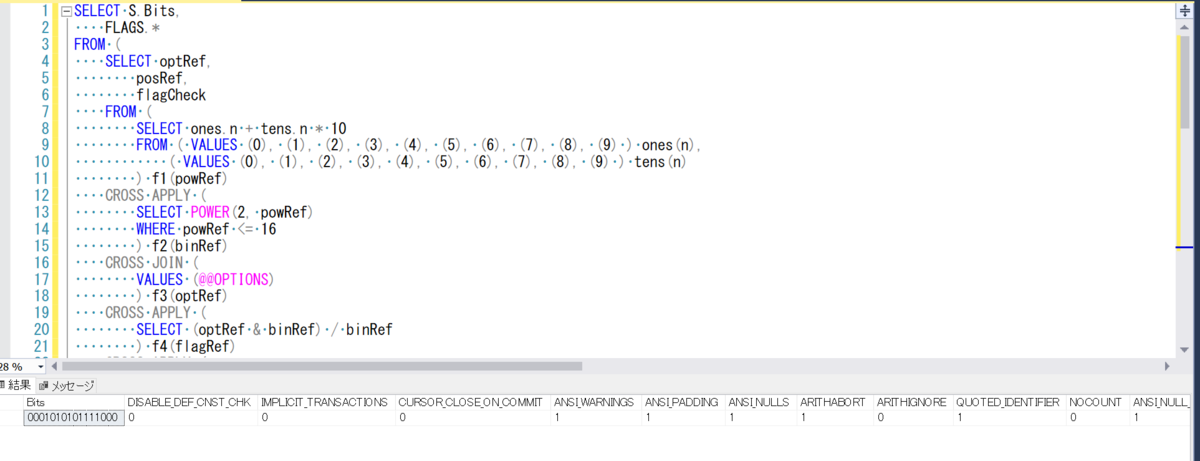SQL ServerのSETオプションの設定を確認する方法を備忘録として、残しておきます。
(といっても、MSDocの内容をそのままコピーしたものですが)
以下のSQLを実行することで、確認できます。
SELECT S.Bits, FLAGS.* FROM ( SELECT optRef, posRef, flagCheck FROM ( SELECT ones.n + tens.n * 10 FROM ( VALUES (0), (1), (2), (3), (4), (5), (6), (7), (8), (9) ) ones(n), ( VALUES (0), (1), (2), (3), (4), (5), (6), (7), (8), (9) ) tens(n) ) f1(powRef) CROSS APPLY ( SELECT POWER(2, powRef) WHERE powRef <= 16 ) f2(binRef) CROSS JOIN ( VALUES (@@OPTIONS) ) f3(optRef) CROSS APPLY ( SELECT (optRef & binRef) / binRef ) f4(flagRef) CROSS APPLY ( SELECT RIGHT(CONVERT(VARCHAR(2), CAST(powRef AS VARBINARY(1)), 2), 1) [posRef], CAST(flagRef AS INT) [flagCheck] ) pref ) TP PIVOT( MAX( flagCheck ) FOR posRef IN ( [0], [1], [2], [3], [4], [5], [6], [7], [8], [9], [A], [B], [C], [D], [E], [F] )) P CROSS APPLY ( SELECT CONCAT ( '', [0], [1], [2], [3], [4], [5], [6], [7], [8], [9], [A], [B], [C], [D], [E], [F] ), CONCAT ( '', [F], [E], [D], [C], [B], [A], [9], [8], [7], [6], [5], [4], [3], [2], [1], [0] ) ) S (stib, Bits) CROSS APPLY ( SELECT CAST(P.[0] AS BIT) /* 1 */ [DISABLE_DEF_CNST_CHK] -- Controls interim or deferred constraint checking. , CAST(P.[1] AS BIT) /* 2 */ [IMPLICIT_TRANSACTIONS] -- For dblib network library connections, controls whether a transaction is started implicitly when a statement is executed. The IMPLICIT_TRANSACTIONS setting has no effect on ODBC or OLEDB connections. , CAST(P.[2] AS BIT) /* 4 */ [CURSOR_CLOSE_ON_COMMIT] -- Controls behavior of cursors after a commit operation has been performed. , CAST(P.[3] AS BIT) /* 8 */ [ANSI_WARNINGS] -- Controls truncation and NULL in aggregate warnings. , CAST(P.[4] AS BIT) /* 16 */ [ANSI_PADDING] -- Controls padding of fixed-length variables. , CAST(P.[5] AS BIT) /* 32 */ [ANSI_NULLS] -- Controls NULL handling when using equality operators. , CAST(P.[6] AS BIT) /* 64 */ [ARITHABORT] -- Terminates a query when an overflow or divide-by-zero error occurs during query execution. , CAST(P.[7] AS BIT) /* 128 */ [ARITHIGNORE] -- Returns NULL when an overflow or divide-by-zero error occurs during a query. , CAST(P.[8] AS BIT) /* 256 */ [QUOTED_IDENTIFIER] -- Differentiates between single and double quotation marks when evaluating an expression. , CAST(P.[9] AS BIT) /* 512 */ [NOCOUNT] -- Turns off the message returned at the end of each statement that states how many rows were affected. , CAST(P.[A] AS BIT) /* 1024 */ [ANSI_NULL_DFLT_ON] -- Alters the session's behavior to use ANSI compatibility for nullability. New columns defined without explicit nullability are defined to allow nulls. , CAST(P.[B] AS BIT) /* 2048 */ [ANSI_NULL_DFLT_OFF] -- Alters the session's behavior not to use ANSI compatibility for nullability. New columns defined without explicit nullability do not allow nulls. , CAST(P.[C] AS BIT) /* 4096 */ [CONCAT_NULL_YIELDS_NULL] -- Returns NULL when concatenating a NULL value with a string. , CAST(P.[D] AS BIT) /* 8192 */ [NUMERIC_ROUNDABORT] -- Generates an error when a loss of precision occurs in an expression. , CAST(P.[E] AS BIT) /* 16384 */ [XACT_ABORT] -- Rolls back a transaction if a Transact-SQL statement raises a run-time error.*/ ) AS Flags;
何やらすごいSQLだなと思いますよね。とりあえず、中身を読み取ろうとはせず私の環境で実行すると以下のようになりました。いい感じですね。各SETオプションごとに、1ならONで、0ならOFFであることが分かります。

しかし、なぜこんなとてつもないSQLなのでしょうか。以下のように「@@OPTIONS」のみをSELECTしてみます。
SELECT @@OPTIONS;

正直意味が分からない結果ですね。MSDocにそれについて記載されたところを抜粋してみます。単純に「@@OPTIONS」を取得した内容は、ビットで表したSETオプションを10進数にした結果が取得できているということみたいです。それをいい感じに表したのが最初のとてつもないSQLということでした。

補足
後で気づいたのですが、以前以下の記事でも同じようにSETオプションを確認する方法を紹介させていただいてました。
SQL Serverで現在の接続でアクティブになっているSETオプションを確認する - ITエンジニアの成長ブログ
上記の記事と、今回の記事の確認方法とで何が違うのかですが、以下のような感じがします(間違ってたらすみません)。
- @@OPTIONSの内容
以下のリンクにある「user options」サーバー構成オプションの設定状況のみを表示する。
user options サーバー構成オプションの構成 - SQL Server | Microsoft Learn
これはサーバーの設定である「user options」の情報を表しているのかなと思いましたが、試しにあるセッションでSETオプションを変えてみたところ上記の確認結果にも反映されたのでそうではないようです。
- DBCC USEROPTIONSの内容
すべてのSETオプションの中で現在のセッションで設定されているものを表示する
SET ステートメント (Transact-SQL) - SQL Server | Microsoft Learn
つまり、基本的には「DBCC USEROPTIONS」を見ておけば良さそうな気がします。他にも違いがあるのかは、ちょっと読み取れませんでした。